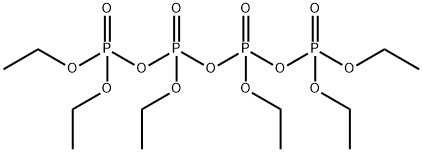- 75760-37-1Acusol 820
- 75-76-3Silane, tetramethyl-
- 75763-51-8Inosine,2'-amino-2'-deoxy- (9CI)
- 7576-65-0C.I. Solvent Yellow 114
- 75-77-4Silane,chlorotrimethyl-
- 75776-67-94-oxopyrrolidine-2-carboxylic acid
- 75776-79-31,4-Dithia-7-azaspiro[4.4]nonane-8-carboxylicacid, hydrobromide, (S)- (9CI)
- 7577-92-62,4(1H,3H)-Pyrimidinedione,5-(methylamino)-
- 7578-25-8D-Glucose, O-6-deoxy-a-L-galactopyranosyl-(1®2)-O-b-D-galactopyranosyl-(1®3)-O-2-(acetylamino)-2-deoxy-b-D-glucopyranosyl-(1®3)-O-b-D-galactopyranosyl-(1®4)-
- 75782-86-4Alcohols, C12-13
Hot Products
- 104987-11-3Tacrolimus
- 141-53-7Sodium formate
- 8001-54-5Quaternary ammonium compounds, alkylbenzyldimethyl, chlorides
- 9003-39-8Povidone
- 10161-34-9Trenbolone acetate
- 402957-28-2Telaprevir
- 68-19-9Cyanocobalamin
- 7631-86-9Silicon dioxide
- 302-79-4Tretinoin
- 77-92-9Citric acid

|
Basic Information |

|
Post buying leads |

|
Suppliers |

| Name |
Diethoxyphosphoryl [diethoxyphosphoryloxy(ethoxy)phosphoryl] ethyl phosphate |
EINECS | N/A |
| CAS No. | 757-58-4 | Density | 1.33g/cm3 |
| PSA | 190.59000 | LogP | 5.68760 |
| Solubility | N/A | Melting Point |
-40°C |
| Formula | C12H30 O13 P4 | Boiling Point | 467°C at 760 mmHg |
| Molecular Weight | 506.30 | Flash Point | 249.5°C |
| Transport Information | N/A | Appearance | N/A |
| Safety | A poison by ingestion, skin contact, intraperitoneal, subcutaneous, intravenous, and intramuscular routes. When heated to decomposition it emits toxic fumes of POx. See also TETRAETHYL PYROPHOSPHATE. | Risk Codes | N/A |
| Molecular Structure |
|
Hazard Symbols | Toxic by ingestion, inhalation, and skin absorption; cholinesterase inhibitor. |
| Synonyms |
Ethyltetraphosphate (7CI); Bladan; HET; Hexaethyl tetraphosphate |
Diethoxyphosphoryl [diethoxyphosphoryloxy(ethoxy)phosphoryl] ethyl phosphate Chemical Properties
IUPAC Name: Diethoxyphosphoryl [diethoxyphosphoryloxy(ethoxy)phosphoryl] ethyl phosphate
CAS: 757-58-4
Formula: C12H30O13P4
Molecular Weight: 506.2538
The Molecular Structure of Diethoxyphosphoryl [diethoxyphosphoryloxy(ethoxy)phosphoryl] ethyl
phosphate (CAS NO.757-58-4):

Density: 1.33 g/cm3
Flash Point: 249.5 °C
Boiling Point: 467 °C at 760 mmHg
Index of Refraction: 1.442
Molar Refractivity: 100.84 cm3
Molar Volume: 380.4 cm3
Polarizability: 39.97×10-24cm3
Surface Tension: 43.1 dyne/cm
Enthalpy of Vaporization: 70.1 kJ/mol
Vapour Pressure: 1.89E-08 mmHg at 25°C
Diethoxyphosphoryl [diethoxyphosphoryloxy(ethoxy)phosphoryl] ethyl phosphate Toxicity Data With Reference
| 1. | orl-rat LD50:7 mg/kg | FEPRA7 Federation Proceedings, Federation of American Societies for Experimental Biology. 6 (1947),335. | ||
| 2. | skn-rat LDLo:15 mg/kg | APTOA6 Acta Pharmacologica et Toxicologica. 4 (1948),143. | ||
| 3. | ipr-rat LD50:2500 µg/kg | JAMAAP JAMA, Journal of the American Medical Association. 144 (1950),104. | ||
| 4. | scu-rat LD50:640 µg/kg | APTOA6 Acta Pharmacologica et Toxicologica. 4 (1948),143. | ||
| 5. | orl-mus LD50:56 mg/kg | FEPRA7 Federation Proceedings, Federation of American Societies for Experimental Biology. 6 (1947),335. | ||
| 6. | ipr-mus LD50:6100 µg/kg | JPETAB Journal of Pharmacology and Experimental Therapeutics. 92 (1948),173. | ||
| 7. | scu-mus LDLo:1 mg/kg | APTOA6 Acta Pharmacologica et Toxicologica. 4 (1948),143. | ||
| 8. | ivn-dog LDLo:1300 µg/kg | JPETAB Journal of Pharmacology and Experimental Therapeutics. 92 (1948),173. | ||
| 9. | ims-dog LDLo:1500 µg/kg | JPETAB Journal of Pharmacology and Experimental Therapeutics. 92 (1948),173. | ||
| 10. | scu-cat LDLo:3 mg/kg |
Diethoxyphosphoryl [diethoxyphosphoryloxy(ethoxy)phosphoryl] ethyl phosphate Safety Profile
A poison by ingestion, skin contact, intraperitoneal, subcutaneous, intravenous, and intramuscular routes. When heated to decomposition it emits toxic fumes of POx. See also TETRAETHYL PYROPHOSPHATE.
Safety Information about Diethoxyphosphoryl [diethoxyphosphoryloxy(ethoxy)phosphoryl] ethyl
phosphate (CAS NO.757-58-4):
RIDADR: 1611
HazardClass: 6.1(a)
PackingGroup: II
Diethoxyphosphoryl [diethoxyphosphoryloxy(ethoxy)phosphoryl] ethyl phosphate Standards and Recommendations
DOT Classification: 6.1; Label: Poison, KEEP AWAY FROM FOOD
Diethoxyphosphoryl [diethoxyphosphoryloxy(ethoxy)phosphoryl] ethyl phosphate Specification
Diethoxyphosphoryl [diethoxyphosphoryloxy(ethoxy)phosphoryl] ethyl phosphate with CAS number of 757-58-4 is also known as Ethyl tetraphosphate ; Hexaethyl tetraphosphate Tetraphosphoricacid,hexaethylester ; HET ; HTP . This product is highly toxic, may be fatal if inhaled, swallowed or absorbed through skin. Contact with molten substance may cause severe burns to skin and eyes. Avoid any skin contact. Effects of contact or inhalation may be delayed. Fire may produce irritating, corrosive and/or toxic gases. Runoff from fire control or dilution water may be corrosive and/or toxic and cause pollution. It may burn but does not ignite readily. Containers may explode when heated. Runoff may pollute waterways. Substance may be transported in a molten form.

